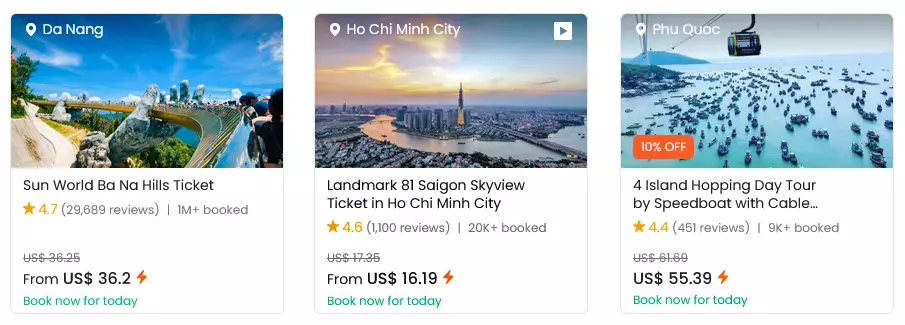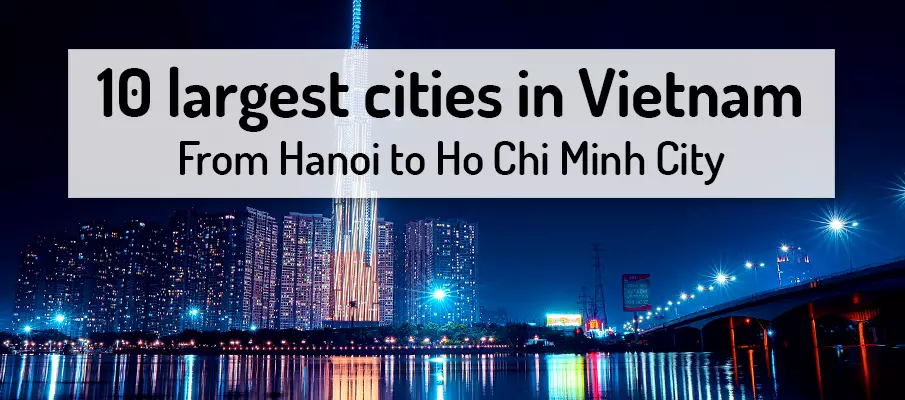
Quick answer: Vietnam’s largest cities offer a diverse mix of culture, history, modern life, and natural attractions. From the energetic streets of Ho Chi Minh City to the historical charm of Hanoi, the coastal beauty of Da Nang and Nha Trang, and the peaceful Mekong Delta atmosphere of Can Tho, each major city provides something unique for travellers.
At a glance:
- 🌆 Ho Chi Minh City (≈ 9.5M): Economic heart of Vietnam with historic landmarks, museums, markets, and the famous Củ Chi Tunnels.
- 🏛️ Hanoi (≈ 9M): Capital known for lakes, temples, the Old Quarter, and important cultural sites.
- ⚓ Haiphong (≈ 2.4M): Major port city near Cát Bà Island and Lan Ha Bay with temples and colonial architecture.
- 🏖️ Da Nang (≈ 1.5M): Clean, modern coastal city with beaches, Marble Mountains, and the Golden Bridge in nearby Ba Na Hills.
- 🌾 Can Tho (≈ 1.5M): Mekong Delta hub famous for floating markets, riverside life, and local culture.
- 🏭 Biên Hòa (≈ 1.4M): Fast-growing industrial center with pagodas, nature reserves, and river scenery.
- 🌊 Nha Trang (≈ 550k): Popular seaside destination with beaches, islands, temples, and mud baths.
- ☕ Buôn Ma Thuột (≈ 540k): Coffee capital with waterfalls, ethnic culture, and highland landscapes.
- 🏯 Huê (≈ 600k): Former imperial capital known for palaces, tombs, temples, and the Perfume River.
- 🚢 Vinh (≈ 800k): Historic port city near beaches, museums, and Ho Chi Minh’s birthplace.
Last updated in November 2025.
Top 10 Largest Cities in Vietnam: Metropolises with Soul, History, and Tourist Potential
Introduction: A Land of a Thousand Faces
Vietnam is a country of fascinating contrasts – from mountainous tribal villages to modern skyscrapers, from peaceful temples to bustling night markets. A land shaped by dramatic historical changes, it now attracts travelers not only with its natural beauty but also with its vibrant culture and the dynamism of daily life.
Tradition, Heritage, and Modernization
In Vietnamese cities, ancient traditions, colonial architecture from the French era, and rapid infrastructure and industrial development come together. Each of these cities offers a unique perspective on Vietnamese identity – whether it’s the cultural capital Hanoi, the commercial heart Ho Chi Minh City, or the seaside resort Nha Trang.
10 Cities, 10 Different Worlds
This article provides insights into the 10 largest cities in Vietnam, each with its own distinctive character. You’ll find not only population figures and historical context but also a selection of six top tourist attractions for each city. This guide will help you discover both well-known and lesser-visited corners of Vietnam and plan an unforgettable journey.
BOOK A TOUR / ACTIVITY in Vietnam ➜
1. Ho Chi Minh City
-
- Population: approximately 9.5 million
Ho Chi Minh City, formerly known as Saigon, is the economic and cultural engine of Vietnam. The city never sleeps – noisy streets full of motorbikes, markets, bars, and street food create a constant stream of life. Although Ho Chi Minh City in southern Vietnam is a modern metropolis, it still bears traces of the French colonial era and the trauma of the Vietnam War. It offers a mix of old and new, luxury and raw authenticity.
6 Main Tourist Attractions in Ho Chi Minh City:
-
- War Remnants Museum – a powerful and moving look at the history of the conflict
- Reunification Palace – a symbol of the end of the Vietnam War
- Notre-Dame Cathedral of Saigon – French neo-Gothic architecture
- Bến Thành Market – a vibrant hub of local commerce
- Củ Chi Tunnels – an extensive network of underground war tunnels
- Bitexco Financial Tower – a modern city skyline with the Skydeck viewpoint
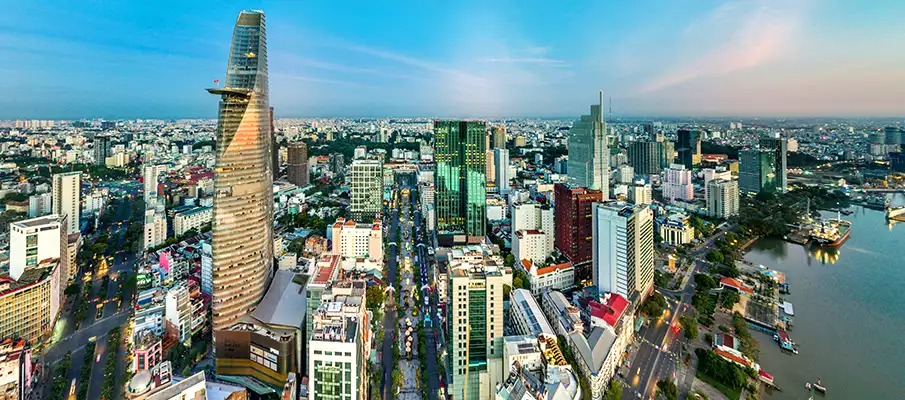
2. Hanoi
-
- Population: approximately 9 million
Hanoi, the capital of Vietnam, is a fascinating blend of history, politics, and culture. At its heart lies the Old Quarter, with narrow streets and traditional craft districts. The city is known for its lakes, temples, and colonial buildings. Despite rapid development, Hanoi retains a strong cultural identity and serves as an ideal starting point for journeys through northern Vietnam.
Top 6 tourist attractions in Hanoi:
-
- Ho Chi Minh Mausoleum – a monumental final resting place of the nation’s leader
- Hoàn Kiếm Lake and Ngọc Sơn Temple – the peaceful heart of the city
- Temple of Literature – Vietnam’s oldest university
- Old Quarter – a lively district full of history and chaos
- One Pillar Pagoda – a unique architectural monument
- Vietnam Museum of Ethnology – an overview of the country’s 54 ethnic groups

3. Haiphong
-
- Population: approx. 2.4 million
Haiphong is a major port city and the third-largest urban area in Vietnam. It plays a vital role in transportation and trade along the northern coast. The city has a strong colonial heritage and an industrial character, but in recent years it has been opening up to tourism, especially due to its proximity to Hạ Long Bay and Cát Bà Island.
Top 6 tourist attractions in Haiphong:
-
- Dư Hàng Pagoda – a historic Buddhist site
- Colonial city center – French architecture and wide boulevards
- Cát Bà Island – a national park, beaches, and hiking opportunities
- Tam Bạc Market – a typical Vietnamese marketplace
- Haiphong Museum – an overview of the city’s and region’s history
- Lan Ha Bay – a quieter alternative to Hạ Long Bay
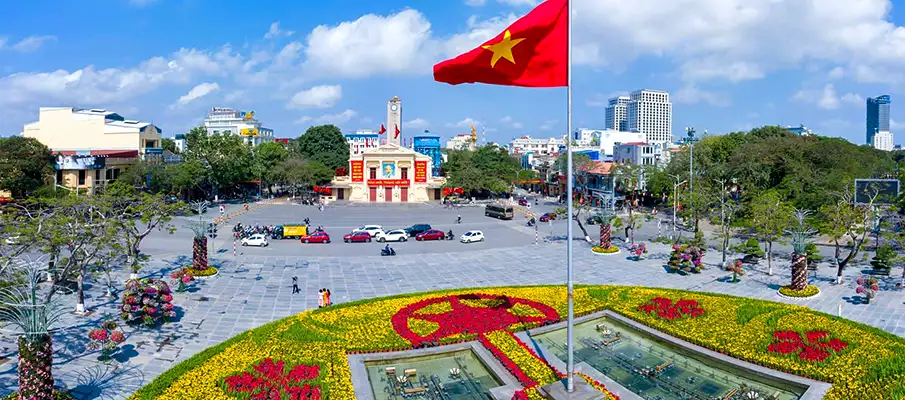
4. Da Nang
-
- Population: approx. 1.5 million
Da Nang is the largest city in central Vietnam and one of the cleanest and most modern cities in the country. It is known for its beaches, rapid development, and accessibility to nearby tourist attractions. It lies between the historic city of Huê and the ancient town of Hội An, making it an ideal base for exploring central Vietnam.
6 main tourist attractions in Da Nang:
-
- Marble Mountains (Ngũ Hành Sơn) – caves, pagodas, and scenic views
- Dragon Bridge – a unique bridge that breathes fire and water
- Mỹ Khê Beach – white sand and clean sea
- Ba Na Hills & Golden Bridge – a futuristic resort with an iconic hand-held bridge
- Champa Museum – a collection of art from the Champa era
- Sơn Trà Mountain (Monkey Mountain) – hikes, monkeys, and bay views
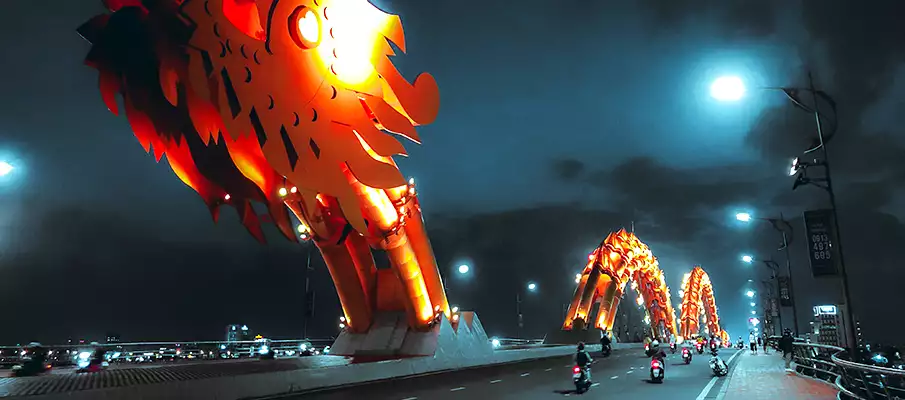
5. Can Tho
-
- Population: approx. 1.5 million
Can Tho is the largest city in the Mekong Delta and a major center of southern Vietnam. The city is known for its floating markets, network of canals, and pleasant atmosphere. It is a key destination for discovering rural life and traditional agriculture in the Mekong region.
6 main tourist attractions in Can Tho:
-
- Cai Rang Floating Market – an authentic experience of a morning market on the water
- Can Tho Museum – history and culture of the delta
- Ninh Kiều Wharf – a popular riverside promenade
- Ông Temple – a Chinese temple in the city center
- Binh Thuy Ancient House – a beautifully preserved colonial villa
- Butterfly gardens and fruit farms in the surrounding area

6. Biên Hòa
-
- Population: approx. 1.4 million
Biên Hòa, located near Ho Chi Minh City, is a rapidly developing industrial city and one of the most important centers in southern Vietnam. Its growth is linked to the expansion of industrial zones and its proximity to the southern capital. Although it’s not a direct tourist destination, there are several natural and cultural attractions in the area worth visiting.
6 main tourist attractions in Biên Hòa:
-
- Bửu Long Pagoda – a stunning Thai-style Buddhist complex
- Óc Island – waterside relaxation and traditional food
- Tân Lân Temple – a historical religious complex
- Dong Nai Culture and Nature Reserve – nature reserve and ecotourism
- Vườn Xoài (Mango Garden Resort) – family fun and animals
- Đồng Nai River – boat trips and local fish specialties

7. Nha Trang
-
- Population: approx. 550,000
Nha Trang is a popular coastal city known for its beaches, coral reefs, and resorts. It’s a magnet for both domestic and international tourists seeking sunshine, water sports, and seafood. With a favorable climate and a wide range of attractions, Nha Trang is one of the most important tourist hubs in Vietnam.
6 main tourist attractions in Nha Trang:
-
- Po Nagar Cham Towers – ancient temple towers from the Champa era
- VinWonders Nha Trang – amusement park on Hòn Tre Island
- Nha Trang Beach – a long sandy beach with a lively promenade
- Trí Nguyên Aquarium – a unique experience for children and adults
- Long Sơn Pagoda – seated Buddha statue and city views
- Tháp Bà Mud Baths – relaxation and therapeutic bathing
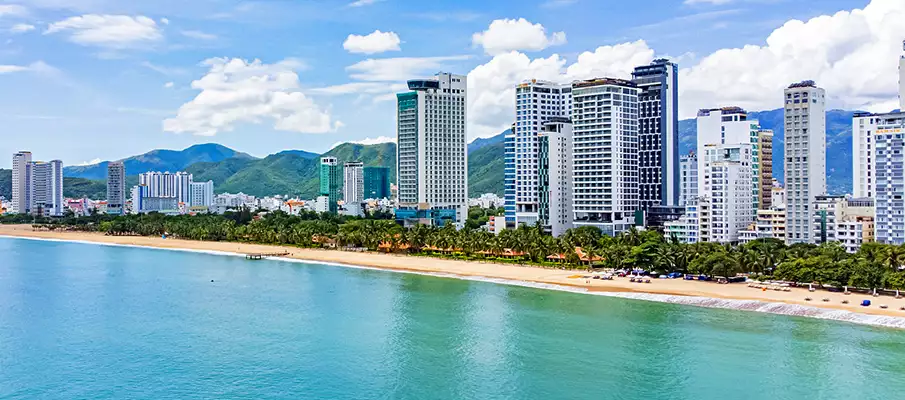
8. Buôn Ma Thuột
-
- Population: approx. 540,000
Buôn Ma Thuột is the capital of Đắk Lắk Province in the Central Highlands and is considered the coffee capital of Vietnam. The city is known for its ethnic diversity, mountainous landscape, and traditional Ê Đê culture. Tourists come here to experience authentic rural life, waterfalls, and excellent coffee.
6 main tourist attractions in Buôn Ma Thuột:
-
- Dray Nur Waterfall – one of the most impressive waterfalls in the region
- Đắk Lắk Provincial Museum – history, culture, and natural heritage
- Trung Nguyên Coffee Village – an interactive space about coffee and its production
- Jeep safari to ethnic minority villages
- Sac Tu Khai Doan Pagoda – modern Vietnamese-traditional architecture
- Lake Ea Kao – a pleasant spot for a picnic and relaxation
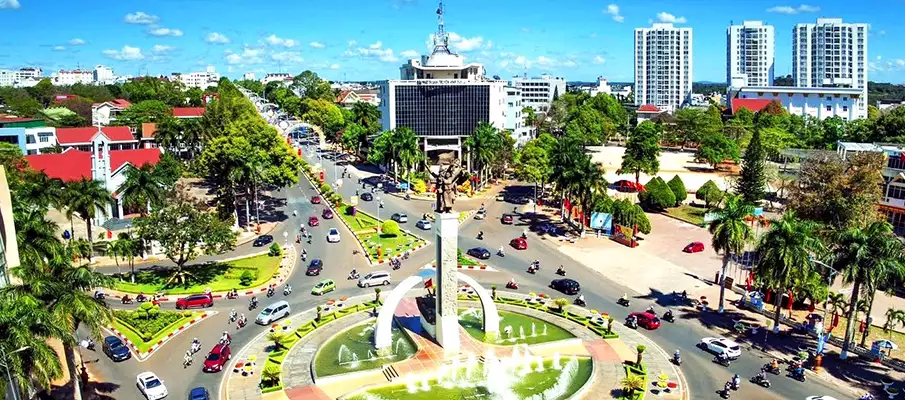
9. Huê
-
- Population: approx. 600,000
Huê is the former imperial capital of the Nguyễn Dynasty and one of the most important historical centers in Vietnam. Located on the Perfume River, the city is famous for its citadel, imperial tombs, and spiritual atmosphere. Huê is a cultural gem where the past echoes through every alley.
6 main tourist attractions in Huê:
-
- Huê Imperial Citadel (Kinh thành Huế) – a vast complex of palaces and temples
- Tomb of Emperor Khải Định – ornate and imposing mausoleum
- Tomb of Emperor Minh Mạng – a harmonious blend of nature and architecture
- Thiên Mụ Pagoda – a symbol of the city on the riverbank
- Đông Ba Market – a place for shopping and tasting local cuisine
- Perfume River (Sông Hương) – sunset boat trips

10. Vinh
-
- Population: approx. 800,000
Vinh is the capital of Nghệ An Province and the birthplace of Ho Chi Minh. Although it is not a typical tourist magnet, it holds a significant place in history and offers an authentic atmosphere of central Vietnam. It serves as an ideal base for trips to nearby mountains, caves, and national parks.
6 main tourist attractions in the city of Vinh:
-
- Ho Chi Minh National Memorial – a complex of museums and monuments
- Cửa Lò Beach Temple – a well-known beach resort
- Quán Hành Pagoda – a spiritual place with a tranquil atmosphere
- Pu Mat Mountains – wild nature and waterfalls
- Thiên Cầm Caves – picturesque coastline and rock formations
- Nghệ An Historical Museum – regional history and cultural heritage

❓ Questions about the largest cities in Vietnam:
1. Why is Ho Chi Minh City considered the economic center of Vietnam?
Ho Chi Minh City is considered the economic heart of Vietnam thanks to its strategic location, modern infrastructure, and high concentration of businesses. The city hosts the country’s largest international airport and seaport, and its dynamic business environment attracts both domestic and foreign investors. It is home to banks, tech companies, and manufacturing plants.
2. What role does Hanoi play as the capital of Vietnam?
Hanoi is the political and cultural center of Vietnam. As the capital, it is home to the president, government, and parliament. The city is known for its historical monuments, museums, and universities. Hanoi is also an important center for education, research, and culture, making it a vital part of Vietnam’s national identity.
3. What makes Hải Phòng stand out compared to other large cities?
Hải Phòng is the largest seaport in northern Vietnam and a vital hub for transportation and industry. Its coastal location makes it a gateway for international trade. The city features rich colonial architecture and rapidly developing industrial zones, making it a key player in the region’s economy.
4. Why is Cần Thơ called the metropolis of the Mekong Delta?
Cần Thơ is the largest city in the Mekong Delta and a vital regional center. It is known for its floating markets, dense network of waterways, and rice production. Its location makes it a commercial and transport hub for the entire region, which is crucial for Vietnam’s agriculture and food exports.
5. How is Da Nang different from other Vietnamese cities?
Da Nang is a modern coastal city that combines quality infrastructure with attractive tourist destinations. It has well-developed transport connections, a modern airport, and tech parks. The city is also known for its beautiful beaches, mountains, and proximity to historic sites like Hội An and My Son.
6. What role does Biên Hòa play in Vietnam’s industrial development?
Biên Hòa, located near Ho Chi Minh City, is one of the main industrial hubs in southern Vietnam. It hosts major industrial zones with hundreds of companies in electronics, textiles, and automotive sectors. Its growth is driven by both domestic and foreign investment and a focus on export-oriented production.
7. What makes Buôn Ma Thuột unique?
Buôn Ma Thuột is the capital of the Central Highlands (Tây Nguyên) and is famous as Vietnam’s coffee center. The region is known not only for its high-quality coffee production but also for its diverse culture of local ethnic minorities. The city is also attractive to visitors seeking natural beauty and highland traditions.
8. What is Nha Trang’s significance for tourism?
Nha Trang is a popular tourist resort known for its long sandy beaches, clear sea, and rich marine life. It offers many hotels, spa resorts, and diving opportunities. Tourists also visit for cultural landmarks like the Po Nagar Towers and modern attractions like Vinpearl amusement island.
9. What makes Thủ Đức special within Ho Chi Minh City?
Thủ Đức is a newly created district of Ho Chi Minh City formed by merging three former districts. It is planned as a technology and innovation hub, with a strong focus on education, research, and modern infrastructure. The zone aims to become a center for startups and high-tech industries.
10. What cultural heritage does Huế offer?
Huế was once the capital of the Nguyễn Dynasty and is now famous for its historical landmarks. Highlights include the Imperial Citadel, royal tombs, and ancient pagodas. The city is listed as a UNESCO World Heritage Site and symbolizes traditional Vietnamese culture, poetry, and cuisine.
BOOK A TOUR / ACTIVITY in Vietnam ➜
| City | Population | Useful Facts and Main Tourist Places |
|---|---|---|
| Ho Chi Minh City | Approx. 9.5 million |
Formerly Saigon, Vietnam’s economic and cultural hub. Famous for busy streets, French colonial history, and Vietnam War sites. Top attractions: War Remnants Museum, Reunification Palace, Notre-Dame Cathedral, Bến Thành Market, Củ Chi Tunnels, Bitexco Financial Tower. |
| Hanoi | Approx. 9 million |
Capital city blending history, politics, and culture with lakes and temples. Top attractions: Ho Chi Minh Mausoleum, Hoàn Kiếm Lake, Temple of Literature, Old Quarter, One Pillar Pagoda, Vietnam Museum of Ethnology. |
| Haiphong | Approx. 2.4 million |
Major northern port city important for transport and trade. Top attractions: Dư Hàng Pagoda, Colonial city center, Cát Bà Island, Tam Bạc Market, Haiphong Museum, Lan Ha Bay. |
| Da Nang | Approx. 1.5 million |
Largest city in central Vietnam, known for cleanliness and beaches. Top attractions: Marble Mountains, Dragon Bridge, Mỹ Khê Beach, Ba Na Hills & Golden Bridge, Champa Museum, Sơn Trà Mountain. |
| Can Tho | Approx. 1.5 million |
Largest city in the Mekong Delta, famous for floating markets and canals. Top attractions: Cai Rang Floating Market, Can Tho Museum, Ninh Kiều Wharf, Ông Temple, Binh Thuy Ancient House, Butterfly gardens and fruit farms. |
| Biên Hòa | Approx. 1.4 million |
Rapidly growing industrial city near Ho Chi Minh City. Top attractions: Bửu Long Pagoda, Óc Island, Tân Lân Temple, Dong Nai Culture and Nature Reserve, Mango Garden Resort, Đồng Nai River. |
| Nha Trang | Approx. 550,000 |
Popular coastal city famous for beaches, coral reefs, and resorts. Top attractions: Po Nagar Cham Towers, VinWonders Nha Trang, Nha Trang Beach, Trí Nguyên Aquarium, Long Sơn Pagoda, Tháp Bà Mud Baths. |
| Buôn Ma Thuột | Approx. 540,000 |
Capital of Đắk Lắk Province, coffee capital of Vietnam. Top attractions: Dray Nur Waterfall, Đắk Lắk Provincial Museum, Trung Nguyên Coffee Village, Jeep safari to ethnic villages, Sac Tu Khai Doan Pagoda, Lake Ea Kao. |
| Huê | Approx. 600,000 |
Former imperial capital, rich in history and architecture. Top attractions: Imperial City, Thien Mu Pagoda, Tomb of Khai Dinh, Perfume River, Tomb of Tu Duc, Dong Ba Market. |
| Vinh | Approx. 800,000 |
Vinh is a lively port city in north-central Vietnam, known for its rich history and culture. Top attractions: Cửa Lò Beach, Ho Chi Minh Square, Quang Trung Museum, Kim Lien Relic Site, Xo Viet Nghe Tinh Museum, Phuong Hoang Cave. |
